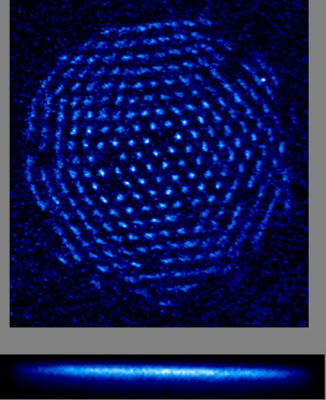
Under certain conditions, trapped beryllium ions form a hexagonal single-plane crystal. This crystal consists of about 300 ions that are spaced about 10 micrometers apart and are fluorescing (scattering laser light). An array of ions such as this might be used as a memory device in a quantum computer.
The new error-suppression method, described in the April 23 issue of Nature,* was demonstrated using an array of about 1,000 ultracold beryllium ions (electrically charged atoms) trapped by electric and magnetic fields. Each ion can act as a quantum bit (qubit) for storing information in a quantum computer. These ions form neatly ordered crystals, similar to arrays of qubits being fabricated by other researchers using semiconducting and superconducting circuitry. Arrays like this potentially could be used as multi-bit quantum memories.
“Quantum computers are inherently prone to errors caused by stray electric or magnetic fields, but theorists have shown that if their error rate is low enough—about one in 10,000—fault-tolerant error correction schemes could enable quantum computations of virtually any length,” said John Bollinger, NIST’s lead scientist on the project. “We have taken an idea that other people have developed and have experimentally demonstrated that we can use it to suppress the errors in quantum computers enough to meet that one-in-10,000 requirement.”
NIST’s dynamic decoupling technique, called spin-echo error suppression, uses the echo from error-suppression pulses to realign the “spins” inside the qubits that simultaneously encode the superimposed ones and zeroes. By regularly applying the error-suppressing pulses, spins that are precessing into error are realigned before they get out of phase enough to cause a hard error.
NIST applied its error suppressing pulses using a microwave photon at 124 GHz. The qubits were stored in an array of 1,000 supercooled beryllium ions, each representing a single qubit trapped by an electric and magnetic field. Solid-state versions of such arrays could act as the memory banks in future quantum computers. NIST’s demonstration showed that the echoes from appropriately timed error suppression pulses can keep the spins of all 1,000 qubits sufficiently aligned to prevent excessive errors.
“Error correction is vitally important for a gate-level approach to quantum computers; they won’t work at all without it,” said Geordie Rose, founder and CEO of D-Wave Systems Inc. (Vancouver, B.C.), a pioneering quantum computer company.
Because of the error-prone nature of general-purpose, gate-level quantum computer architectures, D-Wave instead chose an adiabatic model, which sacrifices generality for robustness. D-Wave’s quantum computer can only solve discrete optimization of multivariable problems. If NIST’s spin-echo error suppression method works as advertised, however, D-Wave claims it may switch back to the general-purpose, gate-level approach.
“Our business model takes an agnostic approach to quantum computing technologies,” said Rose. “We are very much interested in any technique that advances that work, and NIST has certainly proven itself to be one of the leaders.”
MIT Technology review also has coverage of this work.
NIST researchers showed that by applying specially timed magnetic pulses to qubits, made of beryllium ions, they could prolong the life of the quantum bits from about one millisecond to hundreds of milliseconds.

Brian Wang is a Futurist Thought Leader and a popular Science blogger with 1 million readers per month. His blog Nextbigfuture.com is ranked #1 Science News Blog. It covers many disruptive technology and trends including Space, Robotics, Artificial Intelligence, Medicine, Anti-aging Biotechnology, and Nanotechnology.
Known for identifying cutting edge technologies, he is currently a Co-Founder of a startup and fundraiser for high potential early-stage companies. He is the Head of Research for Allocations for deep technology investments and an Angel Investor at Space Angels.
A frequent speaker at corporations, he has been a TEDx speaker, a Singularity University speaker and guest at numerous interviews for radio and podcasts. He is open to public speaking and advising engagements.

